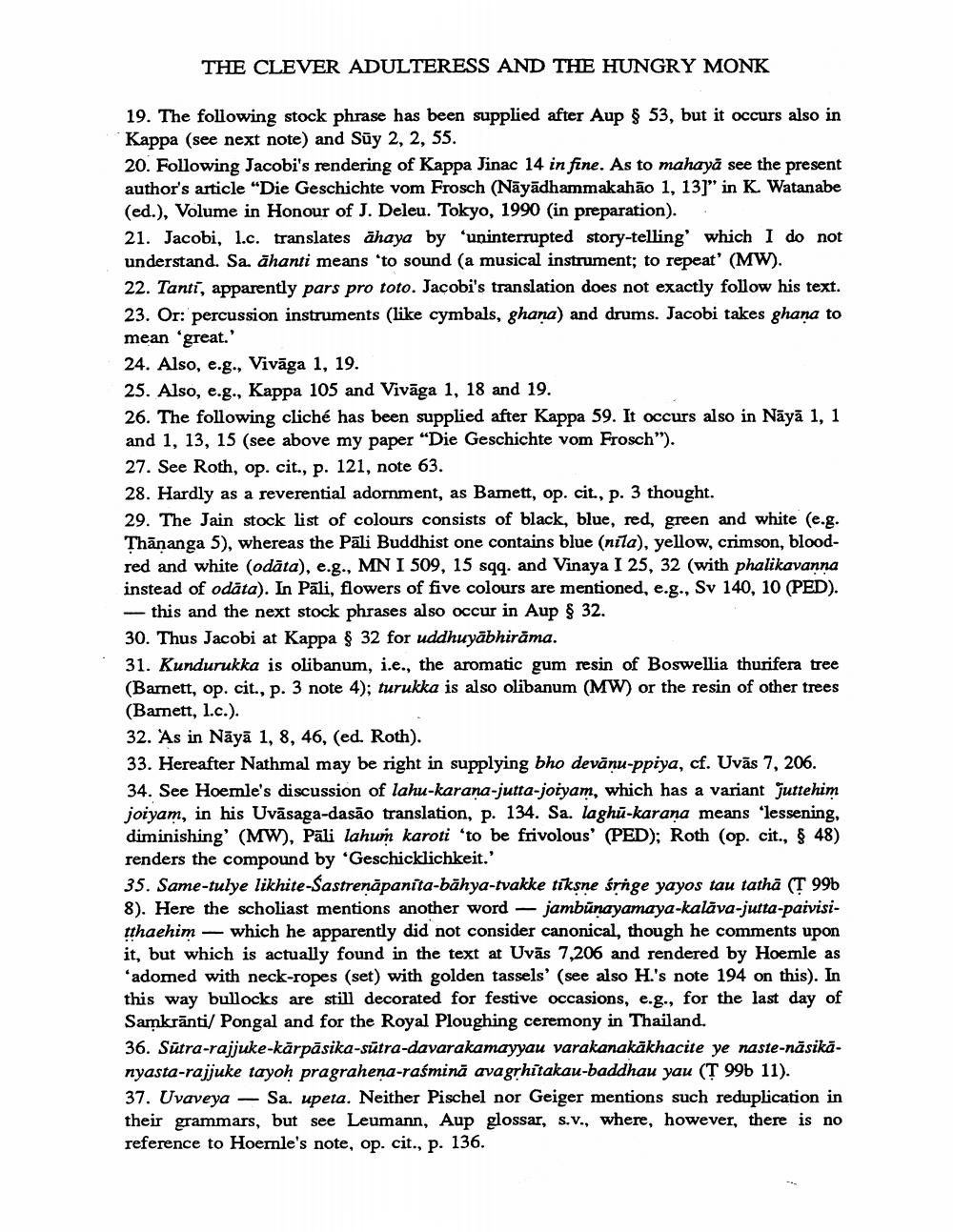________________
THE CLEVER ADULTERESS AND THE HUNGRY MONK
19. The following stock phrase has been supplied after Aup $ 53, but it occurs also in Kappa (see next note) and Sūy 2, 2, 55. 20. Following Jacobi's rendering of Kappa Jinac 14 in fine. As to mahayā see the present author's article "Die Geschichte vom Frosch (Nāyādhammakahāo 1, 13]" in K. Watanabe (ed.), Volume in Honour of J. Deleu. Tokyo, 1990 (in preparation). . 21. Jacobi, 1.c. translates āhaya by 'uninterrupted story-telling' which I do not understand. Sa. āhanti means 'to sound (a musical instrument; to repeat' (MW). 22. Tanti, apparently pars pro toto. Jacobi's translation does not exactly follow his text. 23. Or: percussion instruments (like cymbals, ghana) and drums. Jacobi takes ghana to mean 'great." 24. Also, e.g., Vivāga 1, 19. 25. Also, e.g., Kappa 105 and Vivāga 1, 18 and 19. 26. The following cliché has been supplied after Kappa 59. It occurs also in Nāyā 1, 1 and 1, 13, 15 (see above my paper “Die Geschichte vom Frosch"). 27. See Roth, op. cit., p. 121, note 63. 28. Hardly as a reverential adornment, as Bamett, op. cit., p. 3 thought. 29. The Jain stock list of colours consists of black, blue, red, green and white (e.g. Thānanga 5), whereas the Pali Buddhist one contains blue (nila), yellow, crimson, bloodred and white (odāta), e.g., MN I 509, 15 sqq. and Vinaya I 25, 32 (with phalikavanna instead of odāta). In Pāli, flowers of five colours are mentioned, e.g., Sv 140, 10 (PED). -- this and the next stock phrases also occur in Aup $ 32. 30. Thus Jacobi at Kappa $ 32 for uddhuyäbhirama. 31. Kundurukka is olibanum, i.e., the aromatic gum resin of Boswellia thurifera tree (Barnett, op. cit., p. 3 note 4); turukka is also olibanum (MW) or the resin of other trees (Barnett, 1.c.). 32. As in Nāyā 1, 8, 46, (ed. Roth). 33. Hereafter Nathmal may be right in supplying bho devānu-ppiya, cf. Uvās 7, 206. 34. See Hoernle's discussion of lahu-karana-jutta-joiyam, which has a variant juttehim joiyam, in his Uvāsaga-dasão translation, p. 134. Sa. laghū-karana means 'lessening, diminishing' (MW), Pāli lahum karoti 'to be frivolous' (PED); Roth (op. cit., § 48) renders the compound by 'Geschicklichkeit.' 35. Same-tulye likhite-Sastrenapanita-bāhya-tvakke tiksne śrnge yayos tau tathā (7 996 8). Here the scholiast mentions another word — jambūnayamaya-kalāva-jutta-paivisitthaehim - which he apparently did not consider canonical, though he comments upon it, but which is actually found in the text at Uvās 7,206 and rendered by Hoernle as 'adomed with neck-ropes (set) with golden tassels' (see also H.'s note 194 on this). In this way bullocks are still decorated for festive occasions, e.g., for the last day of Samkrānti/ Pongal and for the Royal Ploughing ceremony in Thailand. 36. Sūtra-rajjuke-kārpāsika-sūtra-davarakamayyau varakanakākhacite ye naste-nāsikā. nyasta-rajjuke tayoh pragrahena-raśminā avagrhītakau-baddhau yau (T 996 11). 37. Uvaveya - Sa. upeta. Neither Pischel nor Geiger mentions such reduplication in their grammars, but see Leumann, Aup glossar, s.v., where, however, there is no reference to Hoernle's note, op. cit., p. 136.




